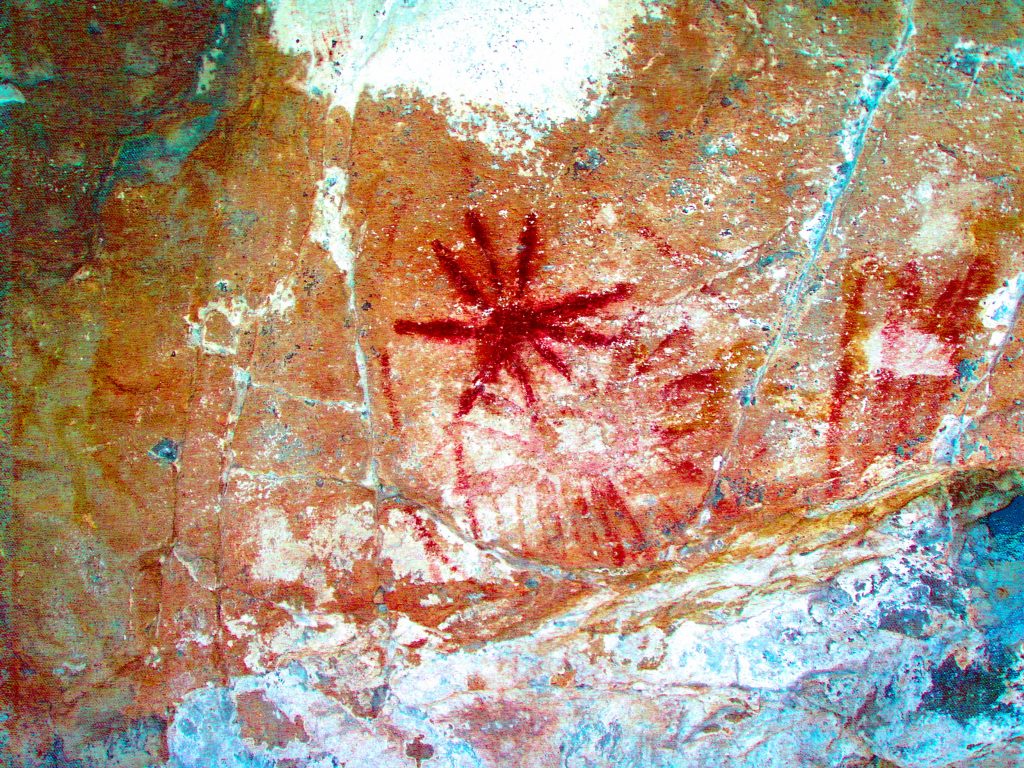
God(s), and The Aftermath of the Missions
The Cochimi God(s)
. . .and what displaced them
Star Pictograph from Cave SB4RC5 by author
The God Symbol ✳
Ask a small child to draw a star and this is likely the image that is rendered to paper. Relatively easy to draw; four strokes producing a star shape with eight rays or arms.
The Asterisk ✳ or star is thought to be one of the oldest known symbols that depict God. It can also be a symbol for our heavenly Sun or an image meaning Unity. The Cupule may arguably be the only older symbol found in rock art and may also be a symbol depicting the first deity known to early humans.
In many rock art locations in Baja a star symbol is found as one of the renderings.
The star is also one of the Phosphene images that is perceived by the visual center in one’s brain when it is receiving stimuli other than visual stimuli. This could be by applying external pressure to the closed eyelid or by looking at a bright object, then closing one’s eyes and seeing the after effect. There can be additional factors such as fatigue, hunger, and trance states either produced by using drugs, self induced or enhanced by rituals and shamanism.
Early humans had a relationship of wonder with their universe, especially with those phenomena that they did not understand rationally such as the rising and setting of the sun and planets. To solve these mysteries then, they created a vast assortment of gods, goddesses and spirit entities to explain anything that was beyond their level of understanding. Consider the tidal ebb and flow into Conception Bay. Was this, in their minds, created by dolphins or turtles and other fish, or was it under the control of the shifting moods of the Sea Goddess of Piedras Pintados?
Our Greek and Roman history depicts gods to explain almost every mystery known to man. Why would the Cochimi be different? They would have experienced areas of unknown in their understanding of their universe and would have created gods or spirit entities to fill those gaps.
The Cochimi also would have had teachings from their leaders and shamans. Any shift of beliefs encouraged by the shamans would normally (probably) have occurred over generations and not without much struggling, much angst, and possibly bloodshed between Cochimi tribes or rancherias. Spiritual enquiry had, up to then, always been the realm of the shamans who would have encouraged their Cochimi followers to have faith in their teachings, even when those teachings would have made no sense to our logical minds today. Into this environment then, entered the Jesuits.
I suspect that the early Jesuit Missionaries would have struggled to replace those early beliefs with the message of Christianity and those early Cochimi gods would not have gone gently into the night. It would have been a messy process to expel one deity and replace it with another. Spiritual beliefs are etched deeply into our psyches at a young age by those we trust and love.
So, with the Jesuits teaching them, the Cochimi intellect would probably have continued to grow and evolve over time enabling them to see deeper into the truth. If. . . if they were to be given the time, training and education to enable this to happen.
“The expanding eyes of man behold the depths of wondrous worlds” (William Blake)
The Aftermath of the Missions
When the Jesuits came to Baja they brought European notions and values. They created the start of another Spanish colony but they never taught the Cochimi how to create a place for themselves within it.
From a larger perspective the Jesuit regime was in many respects a failure. The Cochimi were never really taught to be much more than helpless dependant children. They lived as a perpetual minority isolated and insulated from the new world Spaniards, and also from their own kind. They were never trained to govern themselves in the Spanish fashion or to take their place in the growing civilized society about them. Another historian has observed . . . “ As the passage of time has shown, the missions were preparing the indigenous populations for non-existent places in the larger society”. After the Jesuits were forcibly removed from California in 1769, the Franciscans and Dominicans attempted to bring the missionary work to a satisfactory conclusion. They too failed.
A few peninsular natives married into or co-habitated, with the growing society of Spanish people and added their genes to the growing Hispanic population. Most could not compete however and were not accepted. Disease, starvation and finally old age took these outcasts.
A century and a half then after Padre Salvatierra brought mission influence to Baja, all of the peninsular peoples were gone. All the Pericu, Guaycura. . . all the Cochimi, everyone . . . gone. Their cultures obliterated and assimilated, their language forgotten, their eyes closed, and their faces forever shrouded.
Extracted from An Antigua California by H. Crosby
